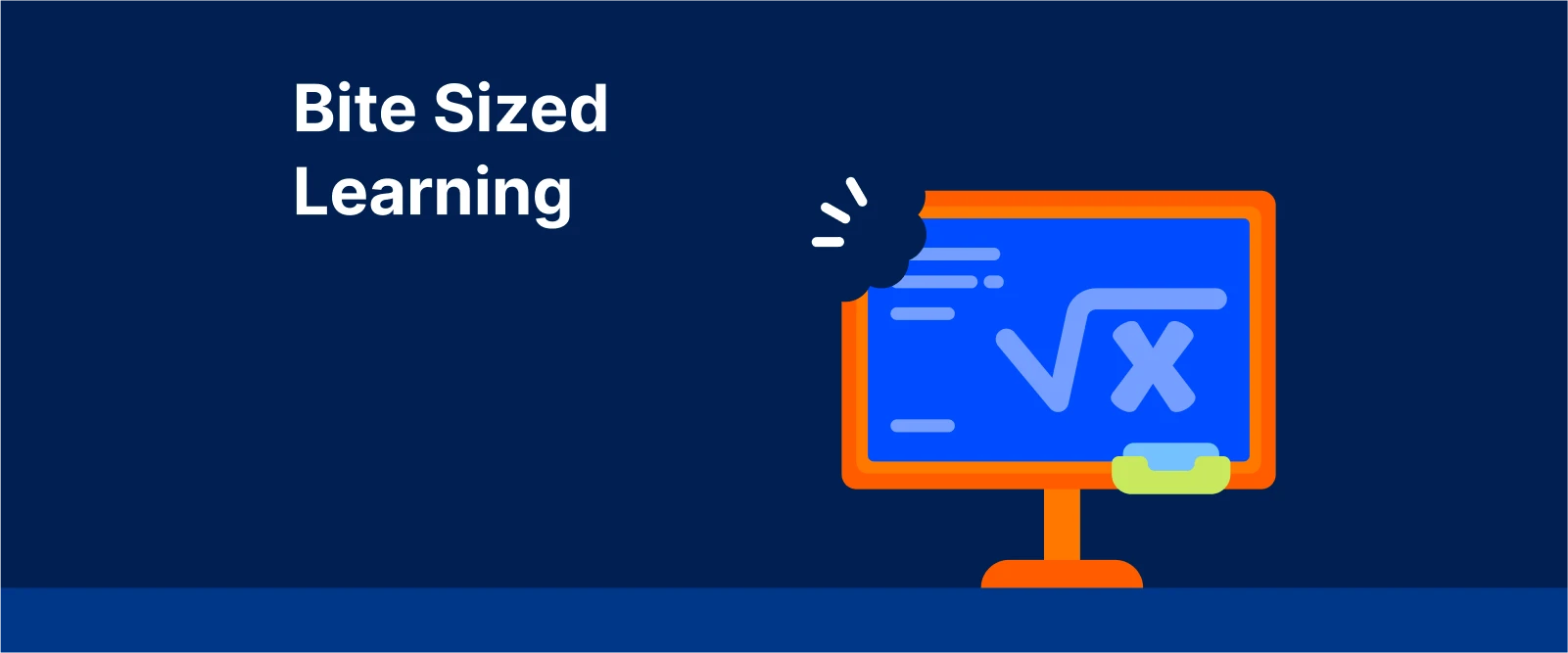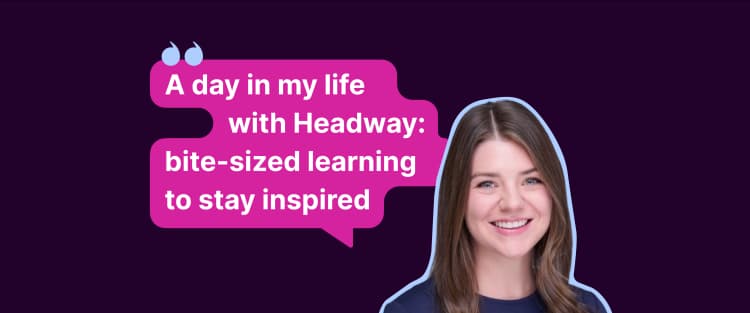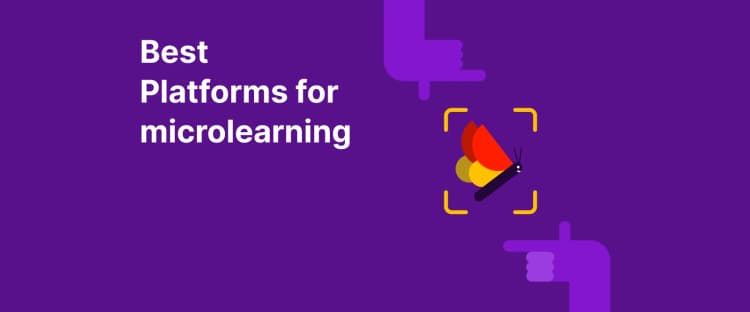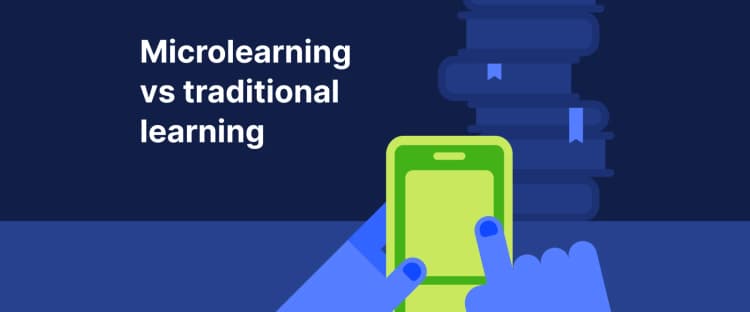Between work deadlines, family gatherings, and everything else on your plate, finding time for traditional learning can feel impossible. That's where bite-sized learning can (and should!) step in.
Bite-sized learning, also known as microlearning, is an educational strategy that turns overwhelming topics into quick, digestible chunks you can tackle in just 1 to 15 minutes. Instead of cramming your brain with everything at once, each lesson focuses on one or two specific things you can actually use and remember.
This system can match any lifestyle and limited attention span by allowing you to learn in short bursts that can be completed quickly and accessed on demand, often right from your phone.
Keep reading to discover how you can educate yourself on the go and why you need to try Headway's microlearning approach.
Why does bite-sized learning work so well?
Short duration: Each session lasts a maximum of 2–15 minutes.
Single focus: One key concept or skill per module.
Immediate application: You can use what you learn right away.
Flexible timing: It fits into any schedule, anywhere.
Progressive structure: Each lesson builds on the previous one.
Five benefits of bite-sized learning
The beauty of bite-sized learning lies in its ability to adapt to your lifestyle while delivering tangible results. You don't need to rearrange your entire schedule or sacrifice other priorities to grow your knowledge and skills.
Let's look at the main reasons why bite-sized learning works so well for lifelong learners.
Better retention
Microlearning increases knowledge retention by 25% to 60% compared to traditional formats, as your brain processes smaller portions of information more effectively.
Bite-sized learning aligns with human natural attention span, rather than fighting against it. When you focus on one concept at a time, you're more likely to understand it deeply and remember it long-term. This strategy controls the muddled thinking that usually comes with cognitive overload.Reduced cognitive fatigue
Traditional learning sessions can exhaust your mental energy, leaving you drained and less motivated to continue. Bite-sized learning prevents this burnout by keeping sessions short enough to maintain peak concentration. Research reveals that learning in micro formats requires 40–60% less employee time than equivalent classroom training, as content can be consumed quickly and efficiently during natural gaps in the day.
Fits your schedule and habits
With microlearning, you never have to choose between learning and living your life, and mobile learning makes this even more convenient. And around 70% of learners feel more committed to using just a smartphone to study. Apps like Headway capitalize on this preference by delivering book summaries directly to your phone, making learning as easy as checking your messages.Just-in-time learning
With bite-sized learning, you can learn exactly what you need, when you need it. Instead of spending weeks learning content to find one relevant piece of information, you can target specific skills or knowledge gaps immediately. Now you can make learning more practical and applicable to your current challenges.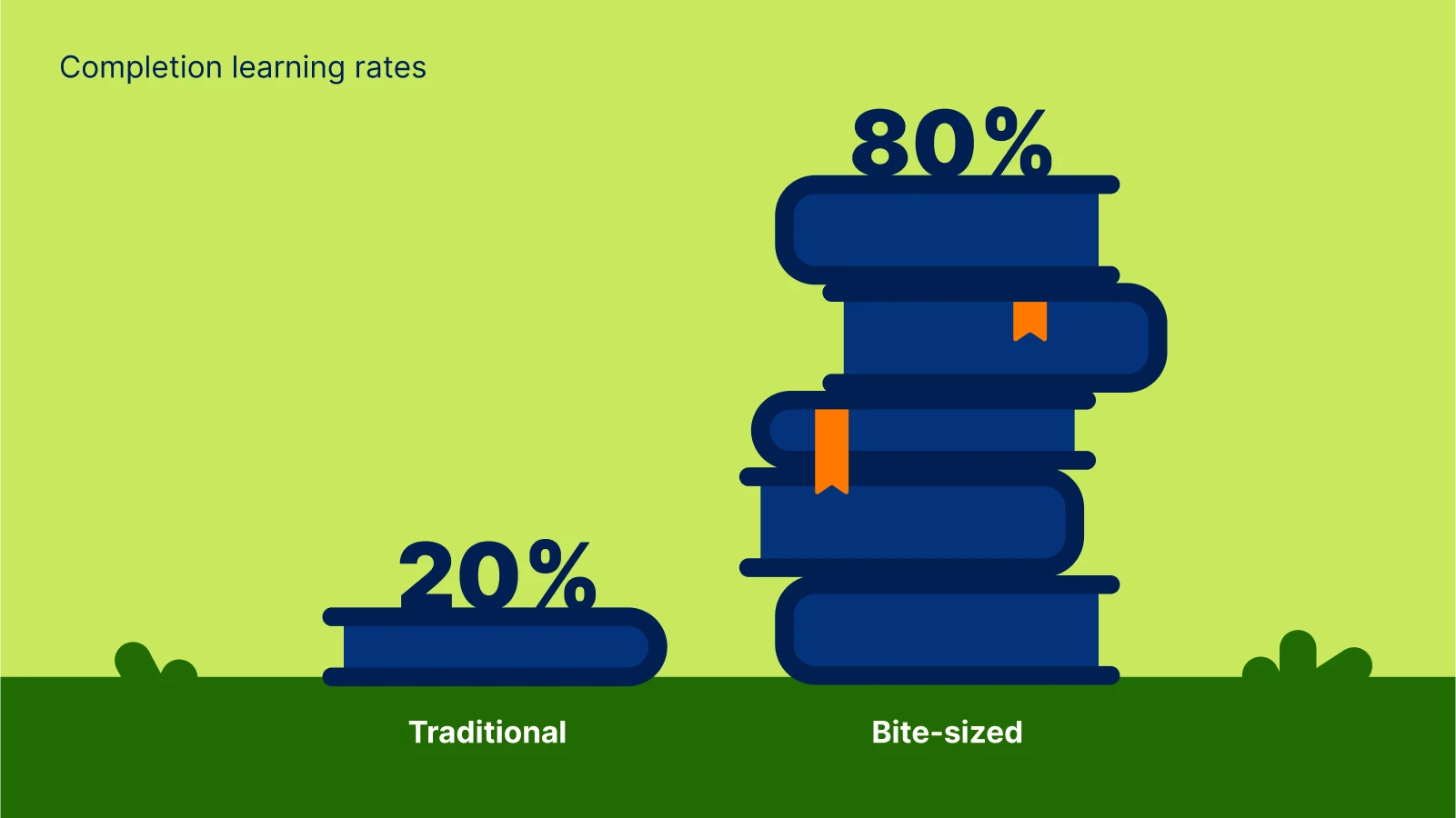
Higher completion rates
Studies show that when bite-sized learning strategies are applied, for example, the course completion rate increases to around 80%, compared to the 20% for traditional long-form e-learning courses. The shorter format makes it easier to finish what you start, giving you a sense of accomplishment that motivates continued learning.
Explore more about how microlearning stacks up against traditional learning methods.
The science behind bite-sized learning: Why does it work?
Research published in The Wall Street Journal confirms that microlearning works with your brain's natural processes, not against them.
But before diving into neuroscience, it's worth noting that breaking information into digestible chunks isn't new.
The first published use of the term "microlearning" dates back to 1963, in The Economics of Human Resource by Hector Correa. But the concept itself has earlier roots in B.F. Skinner's 1960s behavioral psychology experiments explored breaking learning into short, focused interactions.
Later, in 2005, educational theorist Theo Hug helped popularize the term during the world's first conference dedicated to microlearning. And while we often associate microlearning with modern apps, its core principles can be traced back to ancient times, when people taught essential survival skills through quick, focused lessons.
The idea gained momentum with the rise of the Internet in the mid-1990s and exploded with the mass adoption of smartphones around 2007, which made learning on the go truly accessible. Today, microlearning is not only a personal productivity strategy but also the future of corporate training, enabling employees to upskill efficiently in the workplace.
So, why does it work so well?
Attention span alignment: Human attention spans have dropped from 150 seconds in 2004 to just 47 seconds today. The bite-sized modules of 1–15 minutes work perfectly with the modern world.
Working memory optimization: Your brain can only hold 3–5 chunks of information at a time. Small learning processes prevent cognitive overload and improve comprehension.
Spaced repetition benefits: Regular exposure to bite-sized content boosts exam scores by up to 9% through better memory consolidation.
Active learning engagement: Interactive elements in short modules strengthen long-term retention through retrieval practice.
Efficiency gains: Employees trained with microlearning are 17% more efficient than those using traditional e-learning formats.
Visual processing advantage: Your brain processes visuals 60,000 times faster than text. Video-based bite-sized modules improve retention by 20% over other formats.
Research led by educators like Stephen Meyer (principal at BTS., Head of Digital Learning Innovation, Ex CEO of the Rapid Learning Institute) demonstrates that 8–15 minute learning sessions can match or exceed traditional lectures in both engagement and immediate recall.
So, the science is clear: bite-sized learning respects your cognitive limits while maximizing your learning potential.
When bite-sized learning works best — and when it doesn't
Bite-sized learning excels in many situations, but it's important to understand its strengths and limitations. Knowing when to use this approach will help you get better results from your learning efforts.
The key in training sessions is matching the learning format to your specific goals and the nature of what you're trying to learn.
You're definitely already using microlearning
Online learning takes many forms, giving you options to match your learning style and preferences. The variety means you can keep your learning routine new and entertaining while targeting additional types of knowledge and skills.
Popular examples of bite-sized learning:
Video tutorials: 5–10 minute focused lessons on specific topics
Infographics: Visual summaries that break down complex concepts
Flashcards: Quick review sessions for facts and terminology
Interactive quizzes: Immediate feedback on your understanding
Podcast episodes: Audio learning during commutes or workouts
Book summaries: Key insights from full books in 15-minute reads
Microlearning apps: Gamified lessons that make learning addictive
![]()
If you recognized your favorite format above, congrats! You're officially a microlearner.
Think about how you like to learn. Some people enjoy reading reports, applying information to colorful diagrams. Others like listening to podcasts while walking with a dog. Guess what? There's no need to pick just one learning method.
Instead, try mixing various forms to keep things gripping. Maybe you can read a quick summary in the morning, then listen to an affiliated podcast on your way to work. This way, the same idea gets reinforced in your brain from different angles, making it stick better.
The easy way to start a microlearning routine
Creating a sustainable bite-sized learning habit requires strategy and consistency. The goal is to make learning feel effortless and natural, not like another item on your overwhelming to-do list.
Start by picking one subject that genuinely interests you or impacts your personal or career goals. Whether it's improving communication skills, learning more about diet, exploring a new hobby — or even sharpening abilities for your next corporate training — choose something that inspires you to show up consistently.
Follow this roadmap to build the habit:
Week 1-2: Establish your routine with 5-minute daily sessions at the same time each day. This could even be videos on social media. Focus on consistency over quantity. Practicing during morning coffee or lunch breaks works well for most people.
Week 3-4: Increase these sessions to 10–15 minutes and add a weekly review quiz to reinforce what you've learned. Remember, you can use artificial intelligence tools such as ChatGPT, Gemini, or Claude to generate a quiz or test, discuss a topic in a text format, or reflect using the voice message feature. This spaced repetition strengthens your memory.
Week 5-8: Scale by exploring related topics or adding a second learning session at different times of day. Track your progress to maintain motivation.
Your weekly micro-schedule might look like this:
Whatever you plan to include in your schedule, keep in mind that the most important thing is to incorporate hands-on experience into your schedule.
How can you be sure that microlearning is right for you?
Before diving into bite-sized learning, take a moment to consider whether it aligns with your learning style and personality. Not every learning approach works for every person, and that's perfectly okay.
You might love microlearning if you recognize yourself in these cases:
You get distracted easily: Long webinars make your mind wander, but short, focused lessons keep you engaged from start to finish.
You enjoy seeing quick gains: Completing a 5-minute lesson and getting that little checkmark gives you a boost to keep going.
You learn on the phone: Whether you're on the bus, waiting in line, or taking a break at work, you prefer learning that fits in your pocket.
You need answers right now: Instead of searching through a 3-hour webinar for one specific tip, you want to find exactly what you need when you need it.
You work in a fast-changing field: Technology, marketing, or healthcare — if your industry is evolving quickly, you need learning that keeps pace.
However, microlearning might not be your best choice if you're someone who loves diving deep into complex topics for hours, enjoys lengthy discussions with friends, or needs to master something that requires extensive reflection.
Join 50M people who use Headway for bite-sized learning
Headway transforms the world's best nonfiction books into 15-minute summaries that fit perfectly into your bite-sized learning routine. Instead of spending weeks reading entire books, you get the actionable advice in a format developed for busy learners.
What sets Headway apart is the careful curation and structure of each summary. Expert writers distill complex books down to their most valuable concepts, organizing them in a logical flow that builds understanding progressively. You're not just getting shortened versions — you're getting optimized learning experiences.
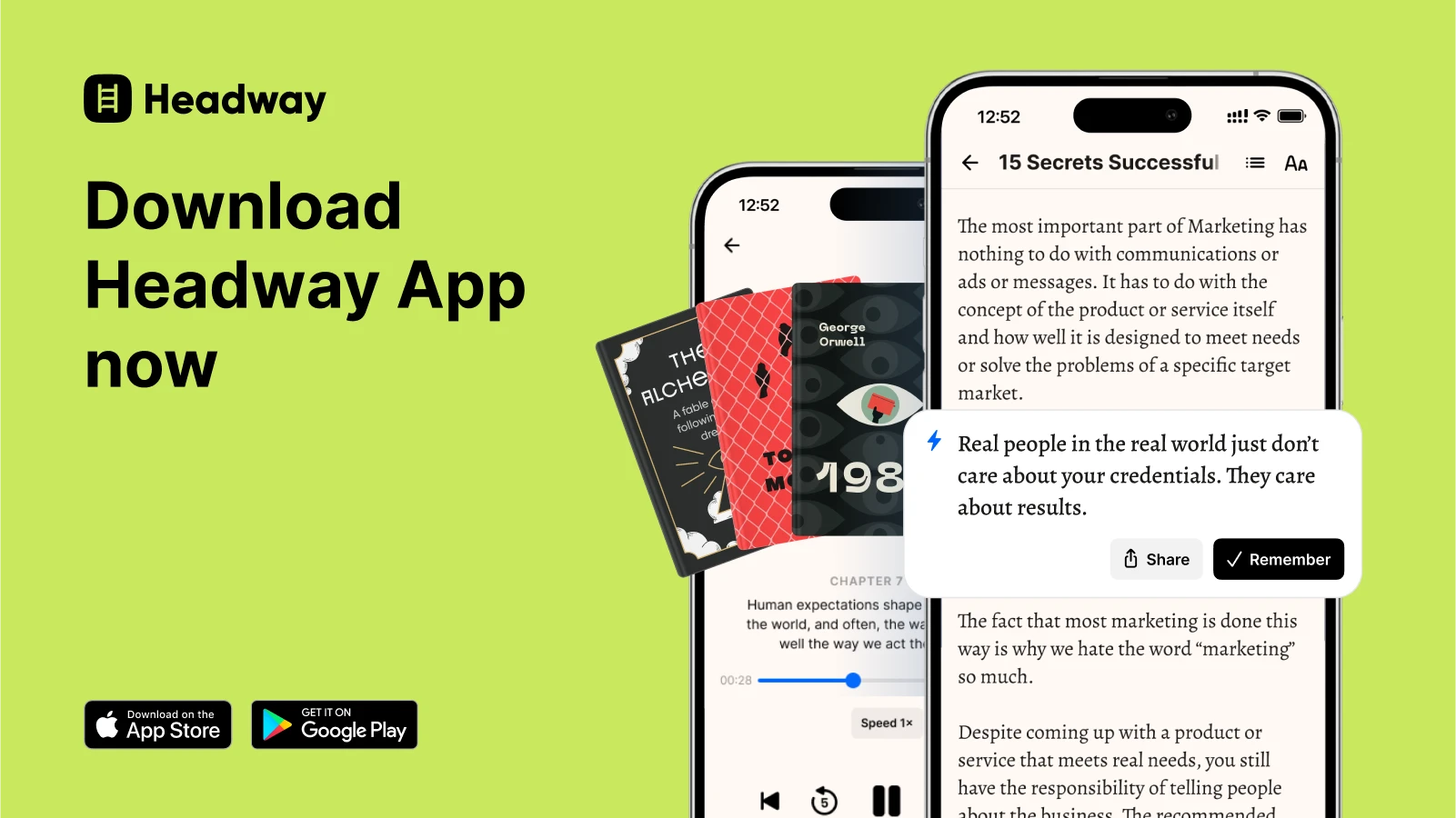
And the best part is that you can try the Headway App for free for 7 days and explore book summaries that interest you most. No pressure — start with topics that genuinely excite you and see how 15 minutes a day can transform your knowledge.
What sets Headway apart from other microlearning apps?
Headway helps start learning start learning anytime, anywhere. Here's what makes Headway perfect for your microlearning journey:
Key takeaways from bestsellers delivered in bite-sized formats that fit your busy schedule perfectly.
Both text and audio options so you can learn while going to work, exercising, or chilling at home.
Personalized recommendations based on your self-growth goals — whether you want to improve your career, relationships with children or partner, or get rid of bad habits.
Progress tracking that shows how much you're learning and keeps you motivated to continue.
Daily learning reminders that help you build a consistent habit without feeling overwhelmed.
Download the Headway App and discover how microlearning can fit seamlessly into your life while delivering the insights and knowledge you've been wanting to gain. Your future self will thank you for taking this first step toward consistent, enjoyable learning that sticks.
Frequently asked questions about bite-sized learning
What is nano learning?
Nano learning involves ultra-short learning sessions lasting 1–5 minutes or less. It delivers particular information for quick problem-solving or as a refresher. Unlike macro learning (traditional long courses), nano learning focuses on narrow topics through brief videos, infographics, or audio clips for rapid consumption.
Which is the most effective learning style?
There's no single "most effective" learning style for everyone. Research shows that multimodal approaches, combining visual, auditory, and hands-on elements, work best. Active learning strategies like the practice quizzes and spaced repetition improve outcomes for all learners, regardless of preferred style.
Is Duolingo microlearning?
Yes, Duolingo offers short lessons that target language skills. Each session includes 12–15 exercises. Similarly, with Headway, you get 15-minute book summaries that break complex topics into digestible chunks, making both apps perfect examples of effective microlearning.
Are microlearning apps worth it?
Absolutely. Research shows that microlearning apps increase knowledge retention by up to 50% and have completion rates of 80–83%, compared to 20–30% for traditional methods. They're 3 times faster to develop, 50% cheaper to create, and perfectly fit busy schedules. Apps like Headway deliver expert knowledge in bite-sized formats that work.
How to create bite-sized learning?
Start with one clear learning objective per module. Break content into 2–15 minute chunks using a mix of formats, such as videos, audio, infographics, etc. Design for mobile devices, add interactive elements, and test with real users. Keep content fresh and personalized for better engagement and retention.
When not to use microlearning?
Avoid microlearning for complex topics requiring deep, sequential understanding or comprehensive mastery. It's not ideal when learners need to see the big picture first, develop hands-on skills through extended practice, or engage in collaborative discussions. Some subjects simply need longer, more immersive learning experiences to be effective.

